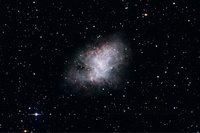

| Home | Research | Publications | Interests | Photos | Contact |
| One of the best parts of my job as an astronomer is travelling to world-class astronomical observatories to study exoplanets using the telescopes there. Sometimes there are a few minutes when my target exoplanetary system isn't observable (e.g. it is too low in the sky) and I already have all the calibration images I need. Then, instead of doing nothing, I try to take pretty pictures of an interesting astronomical object. |
| Astronomical CCDs (cameras) are very sensitive, but usually only work in grayscale, not colour. To get colour images, frames taken using different filters are combined into a single image. Here, the filters used are generally B, V and R, which roughly correspond to the blue, green, and red detected by the human eye. It is possible to use other filters too, for example instead of the R filter in my image of the Whirlpool Galaxy (M51), I used a Hydrogen-alpha (Hα) filter, which corresponds to a particular wavelength of light emitted by hydrogen, in what we perceive as the red part of the spectrum. This colour of light is emitted by regions of partially ionised hydrogen gas where new stars are being formed in the spiral arms of the galaxy. |
| The name of each object appears under its thumbnail image, along with its distance from Earth, the name of the telescope / instrument used to take the image, the filters used and when it was taken. Click on each image for a larger version. |
 |
||||||||
"The Crab Nebula" | ||||||||
6,500 light-years (approx.) | ||||||||
B, V, R filters | ||||||||
2014 October |